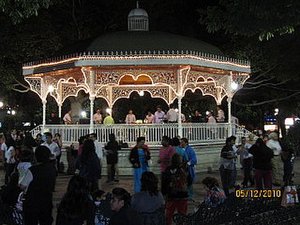Advertisement
Published: December 25th 2017

 Marimba music at night in Tuxtla
Marimba music at night in Tuxtla
Note the age of the dancers - we felt youngGeo: 16.7473, -93.1098
Blog 17
Despite taking 17 hours and leaving at 6.30 pm to travel through the night, the journey was surprisingly pleasant and we both slept reasonably well. Its a wonderful way to appreciate the size of Mexico. We awoke in a different state (Chiapas) and the flat jungle of the Yucatan peninsular had been replaced by rolling hills not unlike the land surrounding stately homes in England with only the tropical vegetation to remind us that we are in Mexico. The people had also changed and we saw many “cowboys” on horseback wearing light coloured “cowboy” hats. As we travelled on, the hills grew into mountains and the road became somewhat scary,with steep drops at the side. It was something of a relief when we descended into Tuxtla.
Tuxtla is a large modern town with nothing really interesting about it (apart from the local park where we saw some amazing birds) but the reason why we came is that it is the access point to the Sumidero Canyon. Our room in the hostel was the nearest thing to a cell I hope I ever experience, but having said that it was immaculately clean, with comfortable beds, and a minor
miracle, really HOT water. The first hot showers we have had in Mexico.
Our first full day here we went by bus to San Cristobal de las Casas which is 2,100 metres high. It is a Spanish colonial town so the buildings reflect the traditional Spanish style with internal courtyards and lots of churches, but then imagine an alpine resort with tropical vegetation and you will have a good idea of what it looks like. We visited the Museo Na-Bolom which means “House of the Jaguar”, a colonial mansion which had fallen into disrepair until 1951 when a Danish archaeologist, Franz Bloom and his wife, the Swiss photographer Gertrude Duby settled there. They were old style explorers and they penetrated the Lacandon forest, untouched by outside contact until then, and afterwards spent the rest of their lives working with the small Lacandon population and recording and helping preserve their cultural artifacts, (the population was so small that it was too late to preserve their culture). In the 1950's the population of the Lacandon area was 1,000. Now it is 200,000 as other indigenous groups have moved further into the forest because of the need for more land. The result is increasing

 Indigenous people selling their products
Indigenous people selling their products
Very different in appearance from the Mayan peopledeforestation which creates a downward spiral of soil erosion, micro climatic changes, less effective cultivation leading to even more deforestation. A very depressing cycle of events.
The museum is interesting on 2 counts, the Lacandon culture and artifacts, but also the insight into the “frontier” lifestyle of the couple and their explorations. It was the period that I read about as a youngster and which stimulated my interest in geography as I wanted to be a explorer (before I moved on to espionage!) but with hindsight I think I value comfort too much to have survived in the jungle for long, (not to mention spiders, snakes and malaria). In fact, Jim thought he had a touch of altitude sickness that night, so he would probably not have achieved his explorer badge either!
Not long after the bus left San Cristobal and climbed through the mountains on the Pan-American Highway we came to a dead stop. There was a serious accident involving a Combi van and a car. The road was blocked in both directions for 2 hours as ambulances and breakdown trucks came up from the town. It brought home to us how isolated the area is and how fragile the

 Local woman sewing
Local woman sewing
in the courtyard of the House of the Jaguarinfrastructure, despite the relatively new highway.
The next day we visited the Sumidero Canyon, eventually, as we had to wait 2 hours until there were enough people to fill a boat. The Canyon can only be seen by boat but it was worth the wait. It is impossible to take a photograph that does it justice because of the scale. At the highest point the cliff walls are nearly 1,000 metres high (about 5 times the height of Beachy head) and the slopes are covered in jungle. Towards the end of the Canyon is a National Park which again can only be reached by the boat which pulls in to the jetty if anyone wants to get off. We did, and wandered through the jungle, seeing birds, some fascinating spiders and a puma. The idea is that the park protects the local flora and fauna but it is too late to save the jaguar which was numerous in the area not that long ago.
A hydroelectricity dam was constructed (in the late 70's, I think) which raised the level of the river in the gorge allowing it to be navigated by boat. Up until that time only 2 expeditions had been able
to get down the canyon.
After 3 nights in Tuxtla it was back on the bus at 11.30pm to travel for 8 hours to Veracruz, on the Gulf Coast as we start to make our way towards Puerto Vallarta for Christmas
Advertisement
Tot: 0.266s; Tpl: 0.011s; cc: 13; qc: 58; dbt: 0.0656s; 1; m:domysql w:travelblog (10.17.0.13); sld: 1;
; mem: 1.2mb













Aranza
non-member comment
Parece bonito aunque nunca lo he visitado . Ahora, Veracruz te va a gustar. Tienes que ir a la cafeteria " La parroquia" y tomarte un buen cafe y llamar la atencion del camarero golpeando con un lado de la cuchara tu vaso. El cafe lo sirve
n en vasos... al menos asi era cuando yo iba alli. Que bueno que te gusto Tuxtla. Un abrazoAranza XX